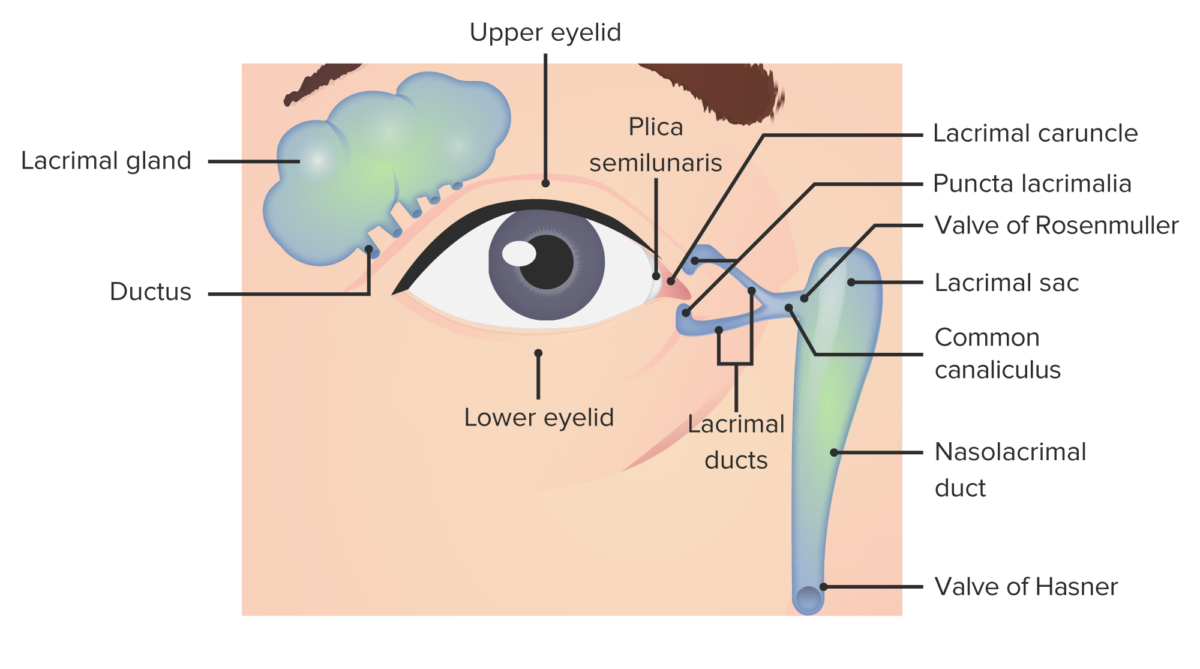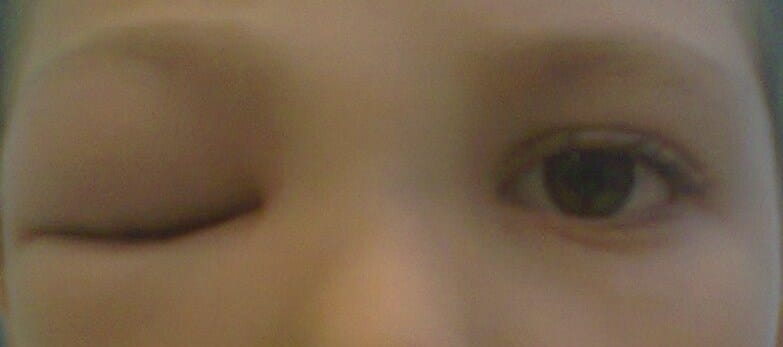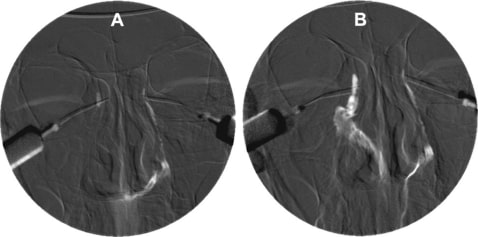Dacryocystitis is the inflammation of the lacrimal sac due to nasolacrimal duct obstruction and the subsequent stasis of tears. The condition can have an acute or chronic onset. Acute dacryocystitis presents within hours or days with redness, swelling, tenderness, and excessive tearing. The chronic type has a gradual course, often manifesting with epiphora. Dacryocystitis can be congenital or acquired. The most common etiology of congenital dacryocystitis is nasolacrimal duct obstruction, which affects 6% of newborns. Acquired cases typically occur in adults and are due to trauma, systemic diseases, or tumors. Diagnosis is made clinically. In some cases, laboratory tests and imaging help determine abnormal structures and underlying disease. Initial treatment includes conservative measures such as Crigler massage, warm compresses, and antibiotics, if indicated. If these fail, surgical options are available.
Last updated: Mar 4, 2024
Dacryocystitis Dacryocystitis Dacryocystitis is inflammation of the lacrimal sac due to nasolacrimal duct obstruction and the subsequent stasis of tears. The condition can have an acute or chronic onset. Acute dacryocystitis presents within hours or days with redness, swelling, tenderness, and excessive tearing. Dacryocystitis is an inflammation Inflammation Inflammation is a complex set of responses to infection and injury involving leukocytes as the principal cellular mediators in the body’s defense against pathogenic organisms. Inflammation is also seen as a response to tissue injury in the process of wound healing. The 5 cardinal signs of inflammation are pain, heat, redness, swelling, and loss of function. Inflammation of the lacrimal sac Lacrimal Sac Dacryocystitis due to nasolacrimal duct Nasolacrimal Duct Nasolacrimal duct. Dacryocystitis (NLD) obstruction and the subsequent stasis of tears.

Lacrimal apparatus anatomy
Image by Lecturio.
Left orbital cellulitis:
Photograph shows left upper and lower eyelid edema and erythema with conjunctival chemosis.

Right preseptal cellulitis:
Image shows marked, isolated, unilateral periocular inflammation. The individual presented with painless eye movement.

Images of lacrimal abscess:
a. and b. Localized right lacrimal abscess, with discharge at the medial canthus;
c. a neonate with right lacrimal abscess;
d. Lacrimal abscess with orbital cellulitis
Clinical[7,10,13]
Testing is based on signs and symptoms.
Laboratory tests[7,13]
Fluorescein dye disappearance test Fluorescein Dye Disappearance Test Dacryocystitis[7]
Imaging[10,13]
Nasal endoscopy Endoscopy Procedures of applying endoscopes for disease diagnosis and treatment. Endoscopy involves passing an optical instrument through a small incision in the skin i.e., percutaneous; or through a natural orifice and along natural body pathways such as the digestive tract; and/or through an incision in the wall of a tubular structure or organ, i.e. Transluminal, to examine or perform surgery on the interior parts of the body. Gastroesophageal Reflux Disease (GERD)[10]
Biopsy Biopsy Removal and pathologic examination of specimens from the living body. Ewing Sarcoma of the lacrimal gland[20]

Digital subtraction dacryocystogram.
A. Completely obstructed right NLD showing no flow of contrast medium. Normal left NLD
B. Free flow of the contrast medium through the recanalized right NLD to the inferior meatus after surgery

A. Clinical photo of a patient with right eye dacryocele
B. CT axial cut showing the medial canthus dacryocele (white arrow)
C. CT coronal cut showing the same finding (white arrow)
Congenital Congenital Chorioretinitis NLD obstruction[10,12]
Acute dacryocystitis Acute Dacryocystitis Dacryocystitis with infection[13,14]
| Medication | Typical adult dose | Typical pediatric dose |
|---|---|---|
| Localized infection | ||
| Amoxicillin Amoxicillin A broad-spectrum semisynthetic antibiotic similar to ampicillin except that its resistance to gastric acid permits higher serum levels with oral administration. Penicillins–clavulanate | 875 mg every 12 hours | 20–40 mg/kg/day in 3 divided doses |
| Cephalexin | 500 mg every 6 hours | 25–50 mg/kg/day divided every 6–12 hours |
| Clindamycin Clindamycin An antibacterial agent that is a semisynthetic analog of lincomycin. Lincosamides | 300 mg every 6–8 hours | 30–40 mg/kg/day in 3 divided doses |
| Complicated cases | ||
| Cefazolin Cefazolin A semisynthetic cephalosporin analog with broad-spectrum antibiotic action due to inhibition of bacterial cell wall synthesis. It attains high serum levels and is excreted quickly via the urine. Cephalosporins | 1 mg IV every 8 hours | N/A |
| Cefuroxime | N/A | 50‒100 mg/kg/day IV in 3 divided doses |
Chronic dacryocystitis Chronic Dacryocystitis Dacryocystitis[6]